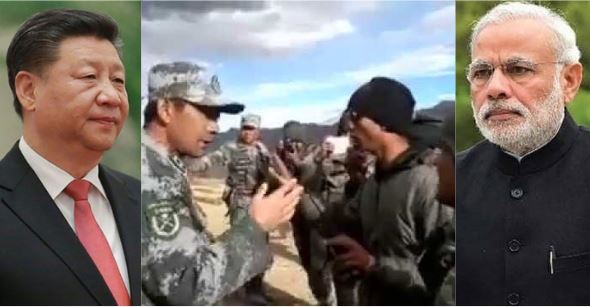One thing that the Wuhan Coronavirus Pandemic has strongly reiterated is the fact that Beijing loves to bully other nations in order to achieve its foreign policy goals. And this time around China is trying to bully India with intense face-offs in Eastern Ladakh and North Sikkim between the Indian Army and PLA soldiers.
The two incidents that happened in high altitude border areas- ‘Naku La sector’ in Sikkim and Eastern Ladakh unsurprisingly coincide with India’s lead role at the WHO, and expose Beijing’s old habits of engaging in clashes and tussles, in order to browbeat its neighbours ahead of crucial summits and negotiations.
To shed some light on the two incidents of border clashes, it has been reported that the soldiers of two sides clashed along the disputed Indo-China border on Saturday, 5,000 metres above sea level at the ‘Naku La sector’ which led to minor injuries on both sides.
However, the two sides disengaged after an interaction at local level and the situation didn’t take the shape of a stand-off, while the face-off itself was “temporary and short duration” in nature.
A more tense situation however developed in Eastern Ladakh and details of the ongoing development reveal a clash much with greater intensity and bigger ramifications.
The clash took place at ‘finger 5’- a point where pitched battles were fought during the 1962 Sino-India war. Soldiers on both sides have reportedly sustained injuries, the nature of which is not yet known after 250 soldiers clashed at an altitude of around 14,000 feet.
Disengagement of the kind that happened in Sikkim hasn’t happened in Eastern Ladakh, and matters flared up again, after a meeting of senior commanders. In fact, tensions are still simmering and it needs to be watched closely if this will escalate into a ‘stand-off’ like situation.
In Eastern Ladakh, a clash has taken place for the first time after 2017 and in Sikkim too, tensions have risen for the first time since the 73-day long Doklam stand-off three years ago.
The timing of the sudden Chinese aggression is interesting, to say the least- India will be assuming the charge of the Geneva-based World Health Organisation (WHO) Executive Board.
The intergovernmental body has been behaving like Beijing’s proxy throughout the COVID-19 Pandemic, making a detestable attempt to exonerate China for its mishandling of the deadly outbreak, apart from aligning with Beijing in its shameless cover-up of the severity of the Pandemic.
WHO got compromised to China’s influence and started castigating other countries for taking preventive measures instead, which has landed the entire world in trouble today.
According to reports, pressure has been mounting on India from several quarters to call out Beijing and put things in order at the WHO- The US, Australia, Japan and other such countries that represent the free world are reportedly nudging New Delhi to take a tough stance against Beijing.
These countries- all of them bearing close, strategic ties with India have two-fold objectives to achieve: Taiwan’s membership in the World Health Organisation (WHO), and an independent international investigation into the origins of the Coronavirus Pandemic- a demand that has become quite popular ever since accusations of the Pandemic originating from a Wuhan laboratory started doing the rounds.
The two demands are seen as a part of the larger Indo-Pacific framework in which Japan and Australia are key partners and which is of immense significance to India also. If the United States, Japan and Australia- countries that are crucial to India’s geo-political and geo-economic ambitions want India to take a stand, then it is unlikely that New Delhi would refuse.
Taiwan recently donated 1 million surgical masks to India and it has called for India’s support for its participation in the WHO meet, World Health Assembly (WHA), which will be held in Geneva on May 18.
Realising that India could side with these countries, the Dragon fears getting its tail twisted as soon as India takes charge of the WHO Executive Body that implements decisions and policies of the World Health Assembly, the main decision-making body of the WHO.
And this is why China is trying to flex its muscles in Eastern Ladakh and Sikkim, as a means of threatening India with dire consequences if adverse action is taken at the WHO. Remember, Beijing has a history of engaging in tussles along the disputed border before every bilateral engagement in order to gain an upper hand in negotiations.
The Doklam stand-off had also preceded the Wuhan Summit where China’s President Xi Jinping and Prime Minister Modi had held an informal meeting. And now a stereotyped Wuhan is again the reason behind Indo-China flare ups.
China shares a hotbed of border disputes with India and doesn’t resolve them even after New Delhi’s insistence, clearly because Beijing wants to use them as bargaining tools in times like this.
China has kept border disputes living on purpose and is now trying to use them to get New Delhi to back out of any serious action against China for slipping the entire world into an unprecedented public health emergency.
